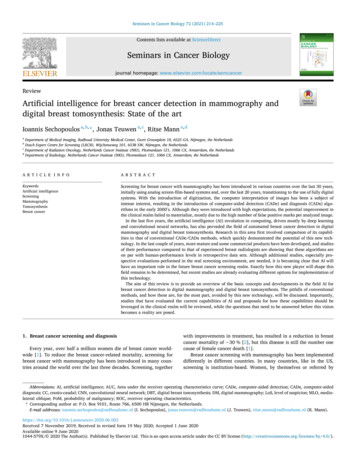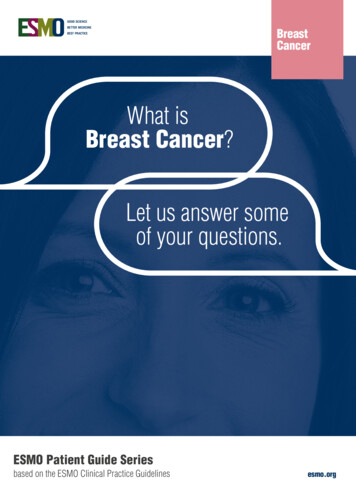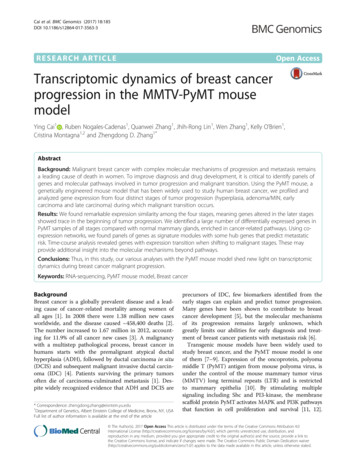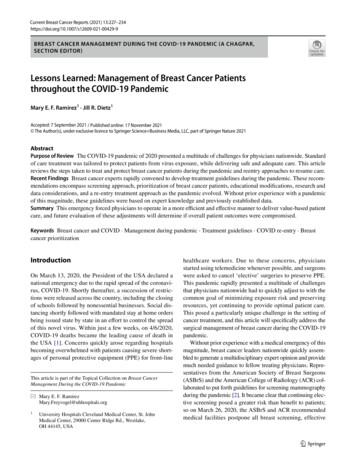
Transcription
Seminars in Cancer Biology 72 (2021) 214–225Contents lists available at ScienceDirectSeminars in Cancer Biologyjournal homepage: www.elsevier.com/locate/semcancerReviewArtificial intelligence for breast cancer detection in mammography anddigital breast tomosynthesis: State of the artIoannis Sechopoulos a, b, *, Jonas Teuwen a, c, Ritse Mann a, daDepartment of Medical Imaging, Radboud University Medical Center, Geert Grooteplein 10, 6525 GA, Nijmegen, the NetherlandsDutch Expert Centre for Screening (LRCB), Wijchenseweg 101, 6538 SW, Nijmegen, the NetherlandscDepartment of Radiation Oncology, Netherlands Cancer Institute (NKI), Plesmanlaan 121, 1066 CX, Amsterdam, the NetherlandsdDepartment of Radiology, Netherlands Cancer Institute (NKI), Plesmanlaan 121, 1066 CX, Amsterdam, the NetherlandsbA R T I C L E I N F OA B S T R A C TKeywords:Artificial t cancerScreening for breast cancer with mammography has been introduced in various countries over the last 30 years,initially using analog screen-film-based systems and, over the last 20 years, transitioning to the use of fully digitalsystems. With the introduction of digitization, the computer interpretation of images has been a subject ofintense interest, resulting in the introduction of computer-aided detection (CADe) and diagnosis (CADx) algo rithms in the early 2000′ s. Although they were introduced with high expectations, the potential improvement inthe clinical realm failed to materialize, mostly due to the high number of false positive marks per analyzed image.In the last five years, the artificial intelligence (AI) revolution in computing, driven mostly by deep learningand convolutional neural networks, has also pervaded the field of automated breast cancer detection in digitalmammography and digital breast tomosynthesis. Research in this area first involved comparison of its capabil ities to that of conventional CADe/CADx methods, which quickly demonstrated the potential of this new tech nology. In the last couple of years, more mature and some commercial products have been developed, and studiesof their performance compared to that of experienced breast radiologists are showing that these algorithms areon par with human-performance levels in retrospective data sets. Although additional studies, especially pro spective evaluations performed in the real screening environment, are needed, it is becoming clear that AI willhave an important role in the future breast cancer screening realm. Exactly how this new player will shape thisfield remains to be determined, but recent studies are already evaluating different options for implementation ofthis technology.The aim of this review is to provide an overview of the basic concepts and developments in the field AI forbreast cancer detection in digital mammography and digital breast tomosynthesis. The pitfalls of conventionalmethods, and how these are, for the most part, avoided by this new technology, will be discussed. Importantly,studies that have evaluated the current capabilities of AI and proposals for how these capabilities should beleveraged in the clinical realm will be reviewed, while the questions that need to be answered before this visionbecomes a reality are posed.1. Breast cancer screening and diagnosisEvery year, over half a million women die of breast cancer world wide [1]. To reduce the breast cancer-related mortality, screening forbreast cancer with mammography has been introduced in many coun tries around the world over the last three decades. Screening, togetherwith improvements in treatment, has resulted in a reduction in breastcancer mortality of 30 % [2], but this disease is still the number onecause of female cancer death [1].Breast cancer screening with mammography has been implementeddifferently in different countries. In many countries, like in the US,screening is institution-based. Women, by themselves or referred byAbbreviations: AI, artificial intelligence; AUC, Area under the receiver operating characteristics curve; CADe, computer-aided detection; CADx, computer-aideddiagnosis; CC, cranio-caudal; CNN, convolutional neural network; DBT, digital breast tomosynthesis; DM, digital mammography; LoS, level of suspicion; MLO, mediolateral oblique; PoM, probability of malignancy; ROC, receiver operating characteristics.* Corresponding author at: P.O. Box 9101, Route 766, 6500 HB Nijmegen, the Netherlands.E-mail addresses: ioannis.sechopoulos@radboudumc.nl (I. Sechopoulos), jonas.teuwen@radboudumc.nl (J. Teuwen), ritse.mann@radboudumc.nl (R. 002Received 7 November 2019; Received in revised form 19 May 2020; Accepted 1 June 2020Available online 9 June 20201044-579X/ 2020 The Author(s). Published by Elsevier Ltd. This is an open access article under the CC BY license (http://creativecommons.org/licenses/by/4.0/).
I. Sechopoulos et al.Seminars in Cancer Biology 72 (2021) 214–225their primary care physician or gynecologist, present at a breast imagingcenter, many times situated in or affiliated with a hospital, for theirscreening exam. Although heavily regulated, the details of the screeningprocess (digital mammography (DM) and/or digital breast tomosyn thesis (DBT), manufacturer, use of computer-aided interpretation, etc.)is decided by the institution. Depending on the institution, the acquiredimages may be interpreted while the woman waits, and any additionalimaging is performed during the same visit. At larger screening centers,the screening exams are read in batches, one or two days after acquisi tion, and if a suspicious finding is detected, the woman needs to berecalled. In many countries, especially in Europe, breast cancer screeninghas been implemented as a government (regional or national) program.In these programs, women of a certain age range (commonly 50–70years old) receive an invitation to get their mammographic screeningexam periodically (commonly every two years). Some screening pro grams have their own dedicated screening centers, un-affiliated withany hospital. In general, there is a larger (or complete) degree of ho mogeneity in the equipment and processes used in these programs. Inscreening programs, the exams are batch-read, and recalls are actuallydenoted referrals, since usually the case is forwarded to a hospital, forfurther imaging and testing.When radiologists are interpreting screening mammograms, they aresearching for lesions with very different characteristics that can bedivided into two broad categories: calcification clusters and soft tissuefindings. The calcifications of interest for the detection of breast cancerare small (as little as 0.2 mm) and relatively high in contrast. The shapeof the calcifications and the distribution of the cluster of calcificationsbeing important biomarkers for malignancy. Soft tissue lesions are ofdifferent types; masses (with different shape and margin descriptors,such as spiculated, smooth, obscured, irregular), architectural distor tions (abnormal configuration of the fibroglandular tissue) and asym metries (dense tissue patterns in one breast with no correspondence onthe contralateral breast).Of course, in the detection of breast cancer, one major biomarker forthe presence of malignancy is a change (for the most part, growth) in thefinding itself. In other words, a suspicious finding that is found to notchange with time is usually deemed as not of concern. Therefore, duringinterpretation of screening mammograms, the comparison to the priorimages is important, in improving both sensitivity and specificity [3–6],and provides additional information different from that gained by otherconcurrent imaging, such as digital breast tomosynthesis (DBT,described later) [7].In many screening programs, especially in Europe, each case isreviewed by two radiologists (usually independently), a process calleddouble reading. Each reader interprets the images and decides whetherthe woman needs to be recalled/referred for further evaluation of asuspicious finding. If the two readers do not agree in their assessment,depending on the program setup, either they meet to arrive at aconsensus, or a third radiologist acts as an arbiter, whose opinion pre vails. Although double reading requires more resources than singlereading (the common process in the US), it has been shown to improvethe cancer detection rate at screening, although it also increases therecall rate, resulting in a comparable positive predictive value [8,9].Aside from double vs. single reading, another major difference be tween screening in Europe and in the US (and some other countries), isthe recall rate, i.e. the proportion of screened women that are recalled orreferred for further testing. As extreme examples, the referral rate in theNetherlands and Sweden is about 2.5 % [10,11], while in the US therecall rate is about 11.5 % [12] (now 30 % lower with DBT). Thisdifference may be attributed, to differences in practice and to themedico-legal implications of a missed cancer.After screening, when a woman is recalled, or referred, she un dergoes diagnostic work-up, to determine if the suspicious finding atscreening is indeed a lesion of concern. This work-up can consist ofadditional DM and/or DBT imaging, ultrasound, and, in some limitedcases, contrast-enhanced breast MRI. Based on this additional imaging,the interpreting radiologist decides if a biopsy is warranted, or if thefinding was a false positive. If a biopsy is performed, depending on thenature of the lesion, this could be done using fine-needle aspiration, coreor vacuum-assisted biopsy, or, in rare cases, an excisional biopsy. Finaldiagnosis is done based on the pathological analysis of the biopsyobtained sample, which, in these cases, determines if the screeningassessment was a true or false positive. If the screening was assessed asnormal, guidelines state that this assessment is considered a true or falsenegative depending on the woman having had breast cancer diagnosedor not during the period in between screening rounds.2. Digital mammographyIn its first implementation, breast cancer screening was performedwith screen-film mammography. Since the early 2000′ s, with theintroduction of affordable large-area digital detectors, digitalmammography (DM) was developed and introduced for clinical use. InDM, the use of film was replaced with a digital x-ray detector, whichwould immediately result in a digital image, ready for evaluation forappropriateness by the acquiring radiographer, and interpretation bythe radiologist. An intermediate, alternative pathway to digitization ofthe breast screening process is the use of computed radiography-basedmammography. However, various studies have shown the inferior per formance of this technology, and therefore its use is being reduced[13–15].DM has various advantages over screen-film mammography, chiefamong them the simpler workflow. In terms of performance, DM hasbeen shown to have improved clinical performance in sub-groups of thescreening population [14,16], but also being equivalent to screen-filmmammography in the general screening population [17–20]. Beyondthese improvements, one additional advantage of the introduction ofdigital detectors for breast imaging is the ease with which the technol ogy can be extended by developing more advanced image acquisitionmethods, such as DBT and dedicated breast CT, as well as the intro duction of post-acquisition processing and analysis algorithms.Mammography, both screen-film and digital, involves the acquisitionof a single two-dimensional image of the breast. This results in thephenomenon of tissue superposition, in which different tissues in thebreast, separated only in the direction of the projection, are projectedonto the same location in the 2D mammographic image (Fig. 1). As aresult, normal tissues may cover up the presence of a malignant lesion,reducing sensitivity, and, the projection of separate normal tissues maymimic a suspicious lesion, reducing specificity. These effects substan tially reduce the accuracy of 2D mammography, especially in breastswith a large amount of fibroglandular tissue (i.e. dense breasts), which ispresent in about half of the screened breasts [21], and is responsible forone third of missed cancers [22].To alleviate the issue of tissue superposition and loss of performancein dense breasts, screening mammography is performed by acquiringtwo views of each breast: the cranio-caudal (CC) and the medio-lateraloblique (MLO) views. These two views are evaluated together by theinterpreting radiologist, in a cognitive effort to determine if a candidatelesion seen in one view is present in the other, or can be discarded asrandom tissue superposition, in addition to the hope that a differentbreast compression direction results in an otherwise occult lesion beingseen in at least one of the views.In summary, interpretation of screening mammograms includes thereview and comparison of features (or lack thereof) across views of thesame breast and across images of the two breasts at the current time point, as well as comparison of images acquired at separate timepoints.Ideally, to maximize performance, any automated image evaluation al gorithm for detecting breast cancer at screening should be capable ofperforming these same comparisons.215
I. Sechopoulos et al.Seminars in Cancer Biology 72 (2021) 214–225Fig. 1. Diagram of a (a) digital mammogram and a (b) digital breast tomosynthesis acquisition. Tissues in the breast that are only separated in the vertical directionappear superimposed in the mammogram, resulting in a loss of sensitivity and specificity. This effect is ameliorated in digital breast tomosynthesis by reconstructinga pseudo-3D image from several projections, each acquired with the x-ray source positioned at a different angle.3. Digital breast tomosynthesislesion being present in each region, and applying a threshold to thisprobability [30]. CADx algorithms estimate if a given, already-detectedlesion is benign or malignant, and therefore involve a similar approachas the final step of a CADe process, albeit without the use of a threshold.To identify and rate the suspiciousness of lesions, conventionalCADe/CADx systems use programmed-in features; the algorithms areprogrammed to search for specific features that humans have identifiedas representative of suspicious lesions. As we will see later, this is theprimary distinguishing feature between conventional CADe/CADx al gorithms and current, state-of-the-art AI-based algorithms.To improve the performance of CADe algorithms, just as done byradiologists, algorithms have been developed to review the informationcontained across the two different (CC & MLO) views of the same breast,and across the matching views of the two breasts. Engeland and Kars semeijer developed an algorithm to detect and evaluate lesions acrossthe two views of the same breast, and incorporated it into a previouslydeveloped CADe program [31]. Tahmoush and Samet, and Wang et al.,proposed algorithms to detect asymmetries across the correspondingviews of the two breasts, resulting, as expected, in a substantialimprovement in the performance of CADe [32–34].CADe was introduced for use during screening to reduce the fre quency of lesions that are overlooked by the interpreting radiologist, as asecond reader. That is, after the interpreting radiologist reviews theentire case and arrives at a decision, he or she would turn on the CADe,and determine if any of the computer-generated marks are of concern ornot [35]. Upon introduction of these algorithms, great promise forimproved outcomes was foreseen, with encouraging initial results [22,36–38]. However, studies that showed improved performance with theuse of CADe were mostly either focused on specific types of lesions orevaluated small, enriched, data sets. After years of clinical use, largescale retrospective analysis of the impact of the introduction of CADe onscreening performance indicated that the expected benefits of CADe didnot materialize [39,40]. Overall, the use of CADe was determined tolower specificity and positive predictive value (the probability of diseasepresent given a positive test), while not resulting in a significant increasein sensitivity. In fact, in a sub-group analysis of radiologists that hadaccess to CADe only a for a portion of their interpretations (due toworking at more than one site), sensitivity was lower when CADe wasused [40]. This points to the possibility that in many cases the CADealgorithm is not used as a second reader, but rather as a first reader, withthe radiologist then only reviewing the marks for deciding to recall ornot.The major pitfall of conventional CAD is the rate of false positivemarks. Good CADe sensitivity performance is achieved only whensetting the internal CADe threshold for marking suspicious areas at ratesOwing to the limitations in DM due to its two-dimensional nature,the last two decades has witnessed the development, and over the lastdecade, the clinical introduction, of digital breast tomosynthesis [23](Fig. 1). DBT is a pseudo-tomographic imaging technique that results ina stack of 2D slices of the imaged breast, with some, albeit limited,vertical resolution. This partial tomographic effect reduces the maskingeffect of superimposed tissues. Studies have reported an increase incancer detection with a, mostly, lowering of the recall rate, dependingon what the baseline (DM) recall rate was [11,24–29].Although trials have resulted in promising results in terms of cancerdetection with DBT at screening, one major drawback is its increase ininterpretation time compared to DM. It has been consistently reportedthat, due to the substantial increase in the number of images needed tobe reviewed, interpretation of DBT images takes approximately doublethe time required for reading DM images [28]. As a result, introductionof DBT in large-scale screening programs will be dependent on not onlyits impact on clinical outcomes, but also in the introduction of methodsto reduce its reading time. Automated methods of interpreting theseimages will surely have an impact in the potential for introduction ofDBT for screening. This impact could be two-fold; in the first place,computer-driven faster navigation of the DBT image stack could result inimportant reductions in the time spent by the radiologist in the visualsearch for suspicious findings. In addition, the use of computer methodsto aid in interpreting the DBT images could reduce the variability seenacross studies in the impact of DBT on recall rate at screening, ifinter-reader variance is reduced.4. Conventional computer-aided detection and diagnosisThe possibility of digitizing screen-film mammograms, and then theintroduction of DM into the clinical realm, resulted in an expandinginterest in leveraging the use of computers to aid in the interpretation ofscreening mammograms. Two categories of computer algorithms wereinvestigated and developed; computer-aided detection (CADe) andcomputer-aided diagnosis (CADx).CADe is aimed at locating suspicious lesions, either soft tissue massesand/or calcification clusters. All conventional CADe algorithms arebased on the same three-part strategy: (i) normalize the image to a“reference” intensity distribution (usually an arbitrary intensity distri bution that the following steps have been prepared for) and/or processthe image to enhance the detectability of suspicious signals, (ii) identifyareas of the image with candidate suspicious signals, and (iii) reduce thenumber of identified regions by evaluating the probability of an actual216
I. Sechopoulos et al.Seminars in Cancer Biology 72 (2021) 214–225above one finding per image. Considering the actual prevalence ofcancer in a screening population, 1% [41,42], or even the recall rate atscreening, 2.4 %–11.5 % [12,42], depending on the country, it isobvious that the great majority of these marks are false positives notonly in terms of malignancy, but also as actionable findings. Therefore,even if a few of these marks prompt the interpreting radiologist toinitiate a recall, then specificity will decline. As far as reducing thenumber of actual overlooked cancers, over 1 000 false positive marksneed to be considered for one additional cancer to be detected [43].Conventional CAD performance on DBT should not be expected to bebetter, given that, for example, a commercial CADe product for DBT wasreported to have a per-lesion sensitivity of 89 %, with a 2.7 1.8 falsepositive rate per view [25]. Several other reported performances forCAD for DBT images are also in the range of 1 or more false positivemarks per view [44].In summary, conventional CAD, for both DM and DBT, has notreached a level of performance that could improve actual screeningperformance in the real world, despite early hopes and promises andyears of clinical use [39,40,45].image analysis, including in the field of breast imaging, has been pub lished by Litjens et al. [48].The major characteristic that distinguishes this new AI-based imageclassification algorithms from conventional CAD is that the determina tion of what image features are indicative of a lesion being present isachieved by the algorithm itself during its training, not input by thehuman programmer. In other words, the algorithm is not taught what abreast cancer looks like (size, shape, texture patterns, etc.) but it teachesitself what it looks like. This is achieved during the training process, byproviding the model many examples of images (portions or completeimages) with and without cancers present, each of them labeled with itsactual status (cancer present/not present). During the training, for eachinput example image the deep learning network adjusts its internalparameter values to minimize the difference between its predicted statusof the image to that of the truth. In this manner, the network recognizeswhat the image features are that point to a malignant lesion beingpresent.One simplifying aspect of obtaining training data for AI algorithms inbreast cancer imaging is that the true status of the case is, relativelyspeaking, straightforward. As opposed to other pathologies, e.g. manycardiac diseases, the determination that a mammogram contains a ma lignant or benign lesion, or no lesion at all, follows a well-acceptedstandard, and the vast majority of studies conform with this, perhapsunwritten, rule. For images containing lesions, their malignant or benignstatus should be confirmed by pathological analysis of biopsy samples,while normal cases normally include one- or two-year follow-up with nocancer diagnosis. In some studies, cases including obviously benign le sions may have not been biopsied, but their benign status was confirmedby long-term follow-up. All of the following studies mentioned here haveused this definition of truth.A distinction should be made between image-level and pixel-levelclassification. Image-level classification involves identifying an entireimage as containing a cancer or not. Pixel-level classification includesdetermining where in the image the lesion is located, either throughproviding a region-of-interest or by labelling each pixel in the image aswhether belonging to a lesion or not. In screening, the basic task isidentifying the person that needs further evaluation due to being at high(-er) risk of having the disease being screened. For example, screeningfor prostate cancer by measuring the level of prostate-specific antigen inblood, or screening for cervical cancer via a pap test, does not provideadditional information on the location or nature of the suspicion.Mammographic screening does result in an indication of where thesuspicion is located and its nature (soft tissue mass, calcifications, etc.).Therefore, any automated DM or DBT image evaluation algorithmshould provide the location of the detected suspicious finding.5. Deep learning convolutional neural networks for medicalimage classificationThe introduction of deep learning convolutional neural networks(CNNs) in medical image analysis has brought forth a potential revo lution in computer-based interpretation of DM and DBT images. Theimportant developments in the last few years in the field are due to theuse of these multi-layered CNNs, but, as in the title of this review, it iscommon to refer to artificial intelligence (AI) and deep learning almostinterchangeably. However, these terms are not synonyms; AI includesmany different types of techniques. Within AI lies machine learning,which includes deep learning of which, finally, CNNs are only a subset[46] (Fig. 2).Deep learning convolutional neural networks involve the processingof an image by multiple, sequential, stages, denoted layers, of usuallysimple multiplication, addition and maximum (convolutions anddownsampling) mathematical operators, that combine the spatiallycorrelated information contained in images. During this multiple-stageprocess, this information is broken down into different representa tions, and the analysis of these more abstract, and simpler, representa tions of this information results in the ability of the network to recognizethe image accurately.Deep learning CNNs first made an impact in image classificationwhen the submission by Krizhevsky et al. won the 2012 ImageNet LargeScale Visual Recognition Challenge by a landslide [47]. Since then, in terest in this technology for various image classification applicationsincreased quickly, and its use for detection of breast cancer inmammography has been investigated for the last few years. A compre hensive survey of the initial introduction of deep learning in medical6. AI-based algorithms for breast cancer detection in digitalmammography and digital breast tomosynthesisBecause of the special characteristics of screening with DM and DBT,algorithms to automatically detect breast cancer in these images usuallygo beyond the “standard” deep learning CNNs. In the first place, algo rithms for breast cancer detection in DM and DBT need to search for bothsoft tissue lesions and calcifications. Given their very different charac teristics and the frequently still-limited training datasets, usuallydifferent separate detection algorithms are used for each of these typesof lesions, and the results are combined at the final stage of analysis. Forexample, Lotter et al. developed a two-stage algorithm, in which firsttwo different multi-scale CNNs, one for masses and the other for calci fications, are used to scan and analyze the image in patches, and then theoutput of these is aggregated to pool together both across lesion typesand analysis scales, resulting in a final classification estimate [49].However, at least one image-level classification network has been re ported on that does not involve separate analysis of the images in searchof soft tissue lesions vs. calcifications, resulting in good performance[50].Fig. 2. Diagram explaining the relationship between the different methods andalgorithms in the field of artificial intelligence.217
I. Sechopoulos et al.Seminars in Cancer Biology 72 (2021) 214–225Also, except for the special application of pre-identification ofnormal cases (as will be discussed later), the algorithm should identifythe location of the suspicious finding(s), not only determine if an imagecontains a suspicious lesion. This requires algorithms that go beyondstandard image classification with DL CNNs. Development of such al gorithms has included combining the information gained from analyzingpatches using hand-crafted features used in conventional CAD with thedeep learning CNN analysis, which has resulted in improved overallperformance at the patch level [51]. Instead of combining the conven tional feature analysis with the CNN algorithm itself, Samala et al. [52]used it as a pre-screening stage to identify suspicious areas of clusteredcalcifications, and then designed a deep learning CNN to differentiatethe true calcifications from false positives, resulting in improved per formance over the use of only a deep learning CNN. Therefore, it seemsthat although the next-generation deep learning CNNs result inimproved performance over conventional CAD, the use of the informa tion gained from the latter, combined with the former, does result in aneven higher performing system.Some work, however, has been performed on using a single CNN,involving the aptly-named algorithm YOLO (You Only Look Once) thatanalyzes the entire image, without the use of more complex, multi-stageor multi-network algorithms, performing both detection and charac terization, resulting in identification of not only the presence of lesionsbut also providing location information [53]. Comparison of its perfor mance to conventional CAD methods shows, not surprisingly, consid erably improved outcomes. Furthermore, its performance compared to apatch-based CNN analysis for characterization only on the same data setwas shown to be equivalent. How this method compares to the otherapproaches, including the combined deep learning-conventional featureanalysis method described above, remains to be seen.It should be noted that methods that include analysis at the pixel- orpatch-level usually require annotated training sets, in which the ma lignant lesions are outlined in the images, or the images consist of onlythe image patches where the lesions are located. This greatly increasesthe difficulty in obtaining adequate training datasets, since annotationof images is a lengthy, tedious process, that needs to be performed bysubject-matter experts, and is still fraught with inter-reader variability[54]. Therefore, minimizing the amount of training that these algo rithms require, and therefore the size of the needed sets, is of interest.One effective way to achieve this is transfer learning [55]. Transferlearning involves using an already-trained deep learning CNN, keeping asignificant portio
process (digital mammography (DM) and/or digital breast tomosyn-thesis (DBT), manufacturer, use of computer-aided interpretation, etc.) is decided by the institution. Depending on the institution, the acquired images may be interpreted while the woman waits, and any additional imaging is performed during the same visit.










